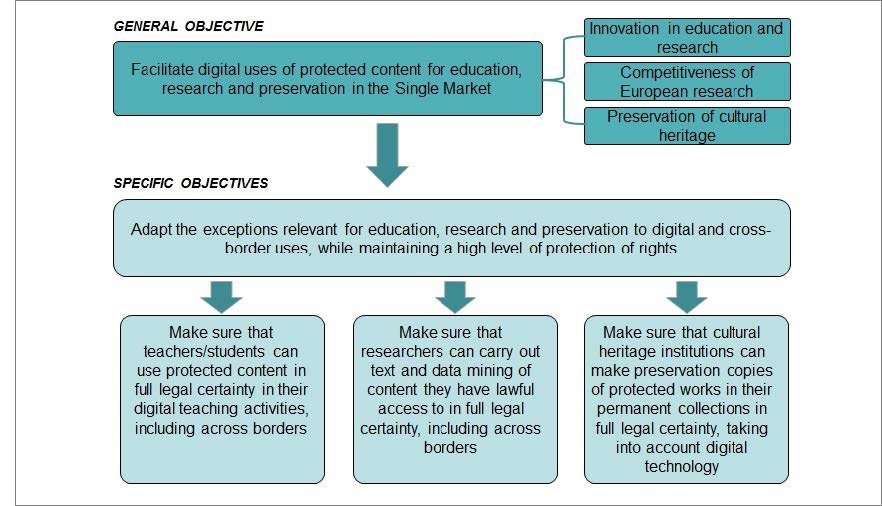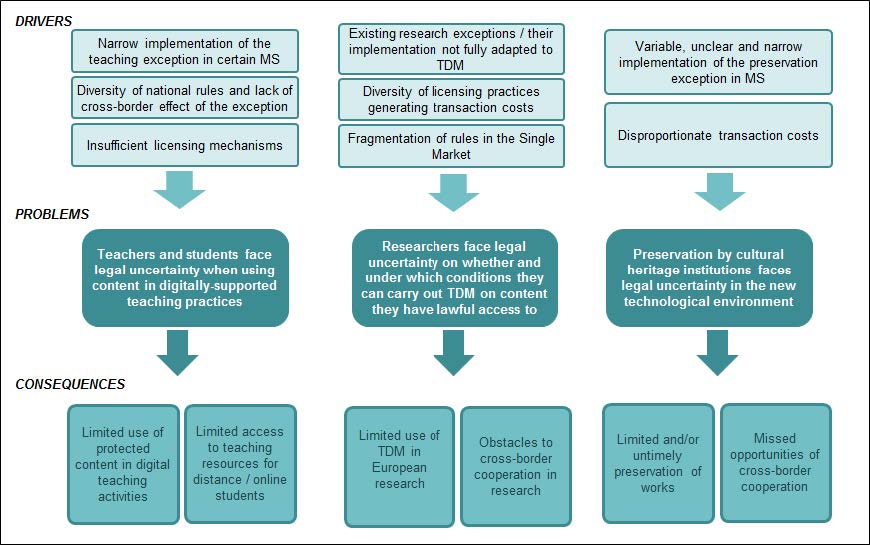The EU copyright legal framework harmonises rights of authors and neighbouring rightholders and seeks to harmonise “exceptions and limitations” to these rights, although most of them are optional for the MS to implement. An “exception” to an exclusive right means that a right holder is no longer in a position to authorise or prohibit the use of a work or other protected subject matter: the beneficiary of the exception is already authorised by law to do so.
Exceptions are provided for in order to facilitate the use of protected content in specific circumstances (for example where the transaction costs involved in acquiring authorisation outweigh the economic benefits of doing so) and/or to facilitate the achievement of specific public policy objectives such as education and research. Beneficiaries of the exceptions may be individuals or institutions.
The existing level of harmonisation limits the possibility for MS to act in the area of copyright as they cannot unilaterally alter the scope of the harmonised rights and exceptions. Therefore, the need to update some of the existing exceptions or to introduce new exceptions, in particular to reflect new digital uses, makes the amendment of EU legislation inevitable.
Moreover, EU intervention is indispensable to achieve one key objective of the copyright modernisation, which is to guarantee legal certainty in cross-border situations. This can only be achieved by making the relevant exceptions mandatory for MS to implement, increasing their level of harmonisation, and, when relevant, recognising their cross-border effect. None of this can be achieved by MS legislation.
Without intervention in EU law, beneficiaries of the exception would face legal uncertainty and may not be able to rely on the exception in cross-border situations (for example teachers in distance learning programmes making content available under the teaching exception in one MS would need to verify whether the same acts are allowed under the exceptions in MS where the students are located, and if not, may have to obtain authorisation from rightholders). Therefore, MS acting alone could not sufficiently address these problems and the objectives can be only achieved by EU action.
The general objective of EU intervention is to facilitate digital uses of protected content for education, research and preservation in the Single Market. Achieving this general objective requires adapting the relevant copyright exceptions to enable digital and cross-border uses, while maintaining a high level of protection of rights. Changes to existing rules should aim at providing legal certainty for the use of protected content in digitally-supported teaching activities, for text and data mining in the context of scientific research and for digital preservation by cultural heritage institutions.
This legal uncertainty is often the result of a restrictive implementation of copyright exceptions for “specific acts of reproduction” and “illustration for teaching and research” in certain MS and/or of the fragmentation of copyright rules and licensing conditions. It can result in a suboptimal use of protected content in the digital environment. The table below illustrates the main differences in the implementation of the exceptions in MS.
| Exception | Implementation in Member States | Main differences in the implementation in Member States |
| Teaching |
|
|
| TDM |
|
|
| Specific acts of reproduction by libraries and similar institutions (preservation) |
|
|
MS are generally in favour of adapting exceptions in order to facilitate digital and cross-border uses of protected content for the purposes of education, research and preservation. They would support further harmonisation of existing exceptions where the uses have a clear cross-border dimension, but are likely to require some flexibility for implementation at national level. Their support to the different policy options will also depend on the balance ensured between the interests of users and rightholders.
The revision of existing exceptions or the introduction of new exceptions need to be assessed in relation to, one the one hand, how they facilitate the access to and use of protected works by certain specific categories of users (educational establishments, research institutions, cultural heritage institutions); on the other hand, how they affect rightholders’ revenues and incentives to create or to invest in the creation of new works.
More generally, it is important to highlight that exceptions need to comply with the ‘three-step test’, enshrined in the main international treaties on copyright, which provides that exceptions may only be applied (i) in certain special cases, (ii) which do not conflict with a normal exploitation of a work or other subject matter, and (iii) do not unreasonably prejudice the legitimate interests of the right holder. The three-step test is also established in Article 5(5) of the InfoSoc Directive.
Preferred options would be those bringing social gains without reducing incentives to create. The main stakeholders affected by the different policy options are certain users and institutional users (teachers, researchers, educational establishments, research institutions, cultural heritage institutions) and rightholders.

